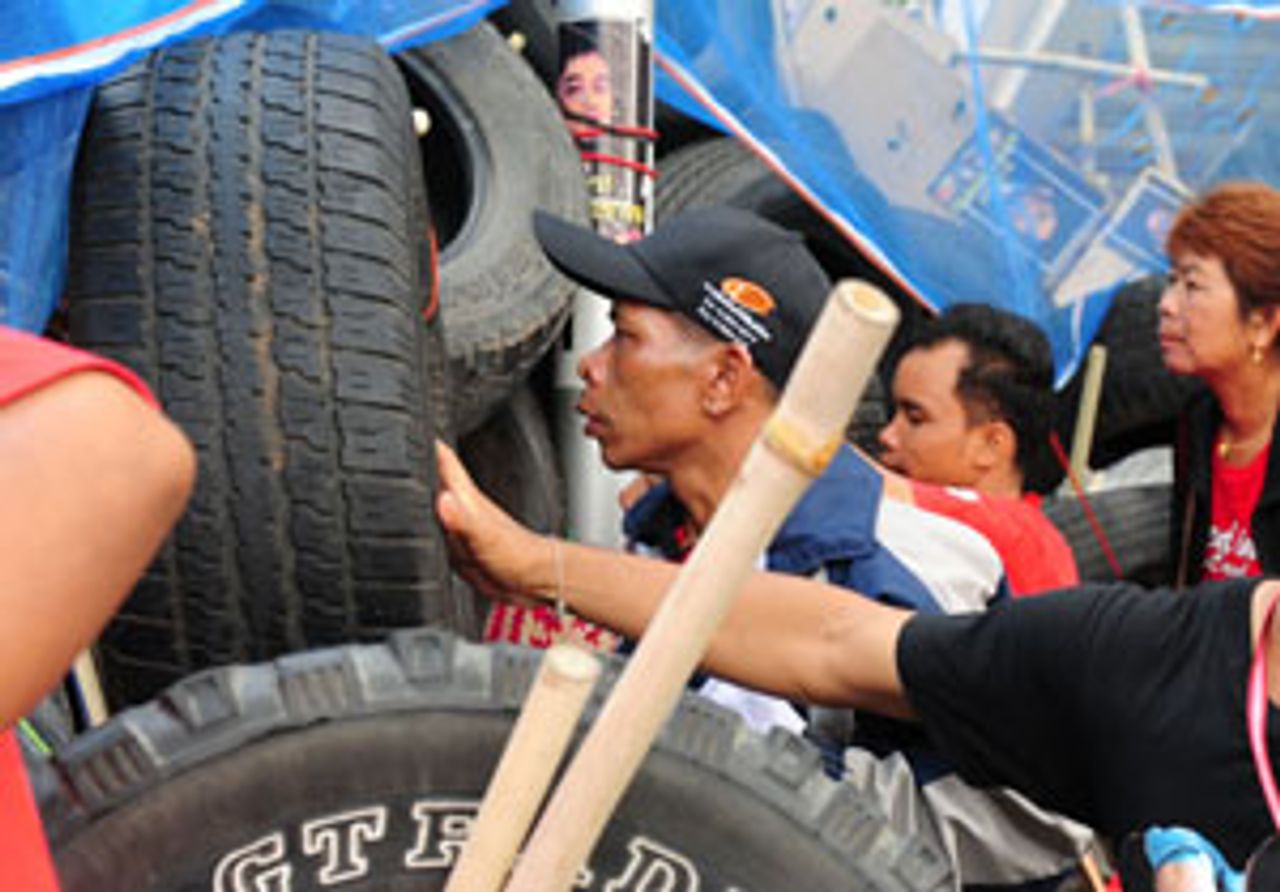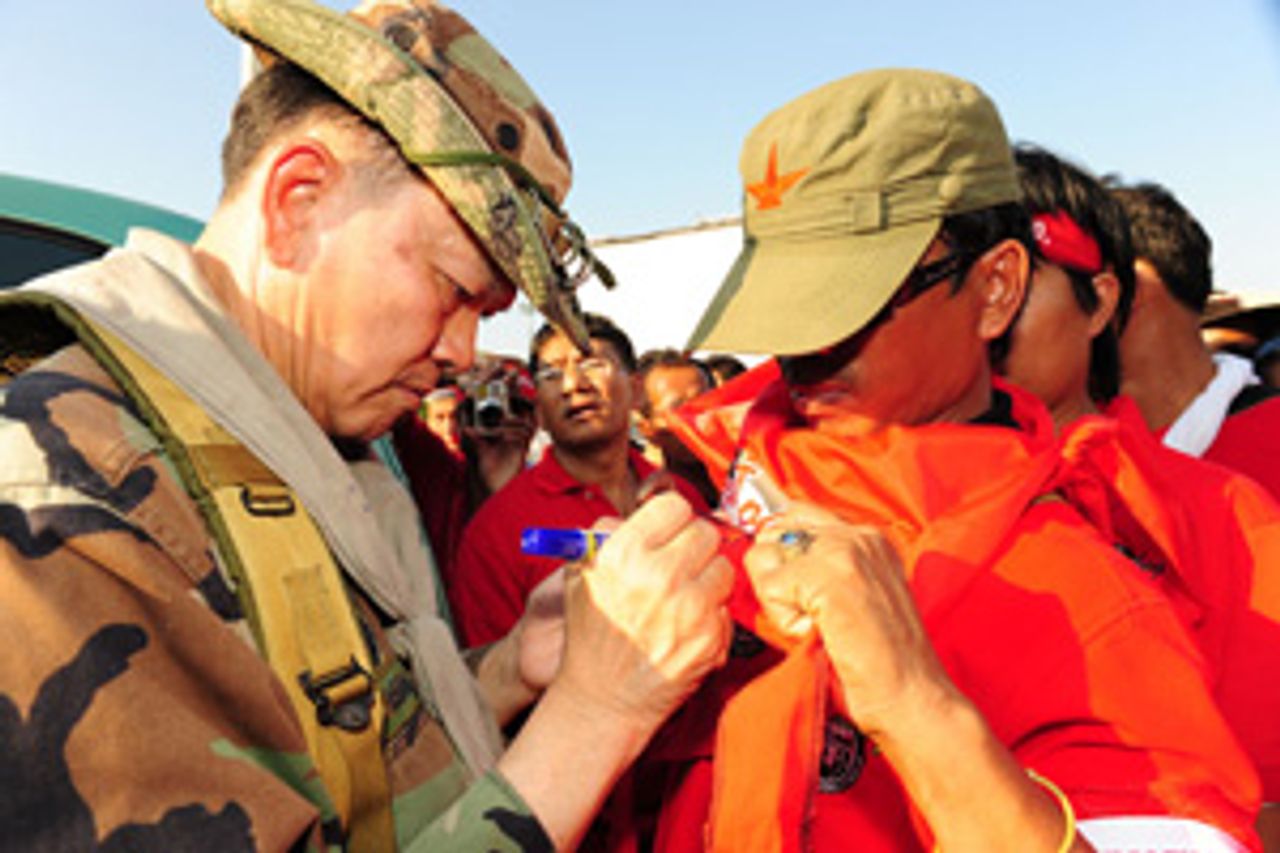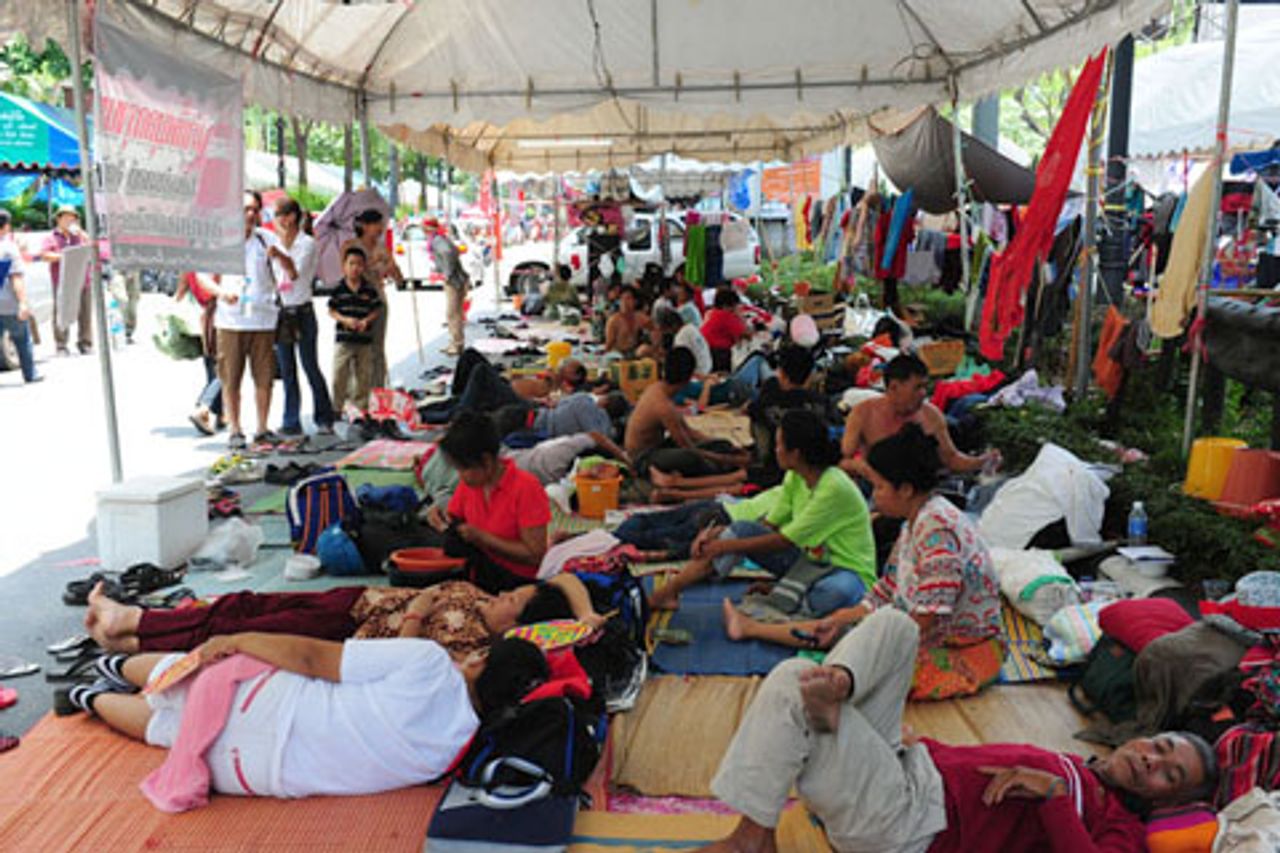At least 10 people have been killed and 125 wounded over the past two days after the Thai military sealed off all access to the United Front for Democracy against Dictatorship (UDD) protest site in the Ratchaprasong commercial district of Bangkok. Three journalists—two Thai reporters and a Canadian cameraman—were seriously injured.
 Protesters manning barricade
Protesters manning barricadeThe siege sets the stage for a bloody confrontation if troops are ordered to disperse the anti-government protesters. The protest site has been surrounded by makeshift barricades. The demonstrators—mostly rural poor from the country’s northern and northeastern provinces—have been joined by sectors of Bangkok’s poor.
Fierce street battles raged yesterday as protesters armed with Molotov cocktails, steel pipes, sling shots and bamboo sticks attempted to prevent troops from erecting barriers. Troops have fired live rounds as well as rubber bullets and are backed by armoured vehicles and snipers. The army is attempting to cut off power, water and mobile phone services to the area. About 10,000 protesters remain at the Ratchaprasong site.
Describing one clash, Time magazine reported: “The soldiers also came under attack from behind after hundreds of slum dwellers from the port neighbourhood of Klong Toey spilled onto the streets to fire rockets and sling shots at the troops… When the Klong Toey mob kept advancing, the soldiers opened fire with rubber bullets. Hundreds of people turned, ducked and ran in a panic, streaming into side streets. At least three people were injured.”
 General Khattiya Sawasdipol (left) signing autographs
General Khattiya Sawasdipol (left) signing autographsProtesters were particularly incensed by the shooting of former army general Khattiya Sawasdiphol, who was hit in the head and critically injured as he spoke to New York Times journalist Thomas Fuller on Thursday. Describing the incident, Fuller said Khattiya appeared to have been shot “from far away and probably from a certain height”. The UDD has accused the government and the military of deploying a sniper to try to kill the controversial general.
Khattiya, who was in charge of security at the protest site, had opposed a government-proposed compromise accepted by UDD leaders to hold elections in November as part of a reconciliation package. The UDD, which backs former Prime Minister Thaksin Shinawatra, had been demanding the immediate dissolution of parliament and an end to the government headed by Prime Minister Abhisit Vejjajiva. The deal broke down on Wednesday when the protesters refused to disperse.
The government had branded Khattiya as a “terrorist” responsible for a number of unexplained grenade explosions, as well as clashes on April 10 when the army attempted to clear another protest site near the Phan Fah bridge in central Bangkok. At least 25 people were killed, including 5 soldiers, and more than 850 injured in hours of street fighting.
Colonel Sansern Kaewkamnerd, spokesman for the government’s Centre for the Resolution of the Emergency Situation (CRES), repeated unsubstantiated allegations yesterday that there were around 500 armed “terrorists” among the protesters. The claim, made by the government and the Bangkok media, is a transparent pretext for a military crackdown on the UDD.
Defence Minister General Prawit Wongsuwon denied that the army was preparing to dismantle the Ratchaprasong protest camp. “The military operation aims to put pressure on the [UDD] Red Shirts to come back to the negotiating table with the government,” he said. The obvious purpose of the siege, however, is not to encourage negotiations but to intimidate protesters and force their dispersal on the government’s terms. Ominously, the CRES has ended its previous practice of giving prior notice of its operations.
 UDD protest site
UDD protest site
Prime Minister Abhisit’s decision on Thursday to extend the current state of emergency to cover 15 provinces in the north and northeast is the clearest indication that the military is preparing to move in. The government and military have previously hesitated to crush protesters in Bangkok, fearful of provoking a rebellion among the rural poor in these provinces. Following the April 10 clashes, protesters in northeastern towns blocked several roads and rail lines to prevent the army and police sending reinforcements to Bangkok.
The current confrontation follows four years of bitter factional feuding in the Thai ruling elite after telecom billionaire Thaksin was ousted by the army in September 2006. The traditional political establishment, centred around the monarchy, army and state bureaucracy, initially supported Thaksin’s election in 2001 but turned on him when he failed to honour his promise to protect Thai businesses hit by the 1997-1998 Asian financial crisis.
Thaksin began to open up sectors of the Thai economy and concentrated power in his own hands, running the state like a corporation. His methods cut across the longstanding networks of patronage on which the army and state bureaucracy depended. At the same time, Thaksin’s limited handouts to the rural poor, as part of his economic stimulus measures, secured a base of support in the long neglected north and north east of the country.
The army relinquished control and held an election in December 2007 under a new constitution but the pro-Thaksin People Power Party (PPP) won the largest share of seats and formed government. After protracted demonstrations by the anti-Thaksin Peoples Alliance for Democracy (PAD) and two court rulings that removed PPP prime ministers, Abhisit was installed with the help of the military in December 2008.
Abhisit is resting on an unstable coalition of his Democrat Party and former PPP allies, including a PPP faction. He has been reluctant to call early elections as it is likely that that the pro-Thaksin party—now known as Puea Thai—would win the most seats.
The protracted political crisis has impacted heavily on the economy, with Finance Minister Korn Chatikavanji estimating that it would cut growth by 2 percent. Reuters reported that foreign investors have sold $584 million in Thai shares in the past six trading sessions. The financial turmoil has in turn hardened the ruling elite’s factional divisions, which centre on economic policy.
At the same time, the economic crisis is deepening social divisions and fuelling demands from protesters for improved living standards. The emergence of elemental class demands from the urban and rural poor has provoked fears, not only in the government but in the UDD leadership, that the protests are slipping out of their control and showing signs of an incipient rebellion.
Former prime minister and Puea Thai chairman Chavilit Yongchaiyudh called on Thursday for the UDD demonstrators to leave their protest site, without success. Thaksin yesterday accused the government of planning a violent crackdown and called on Abhisit to choose peace rather than force. But his list of demands, including the charging of Deputy Prime Minister Suthep Thaugsuban over the April 10 clashes, is unlikely to be accepted.
Fearing the Thai crisis could provoke wider regional unrest, the US and European powers have been pressing for a negotiated end to the standoff. Announcing the closure of the US Embassy in Bangkok, Department of State spokesman Philip Crowley warned: “There are fundamental fissures within Thai society and the only way to resolve this and to develop a civil and inclusive society is through peaceful negotiation.”
That prospect appears increasingly unlikely, however, following the failure of the previous deal and the further clashes and deaths.
